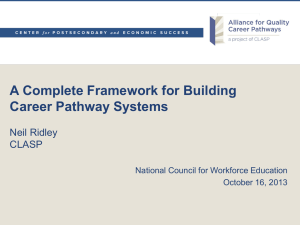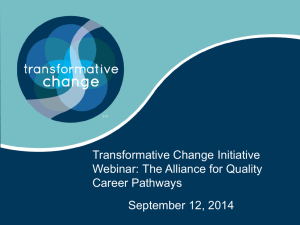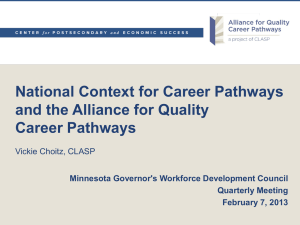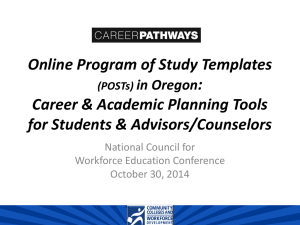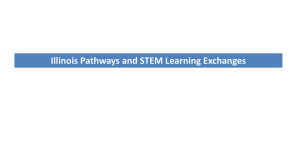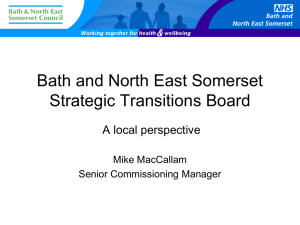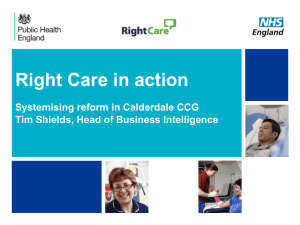Building Criteria and Metrics for High Quality Career
advertisement
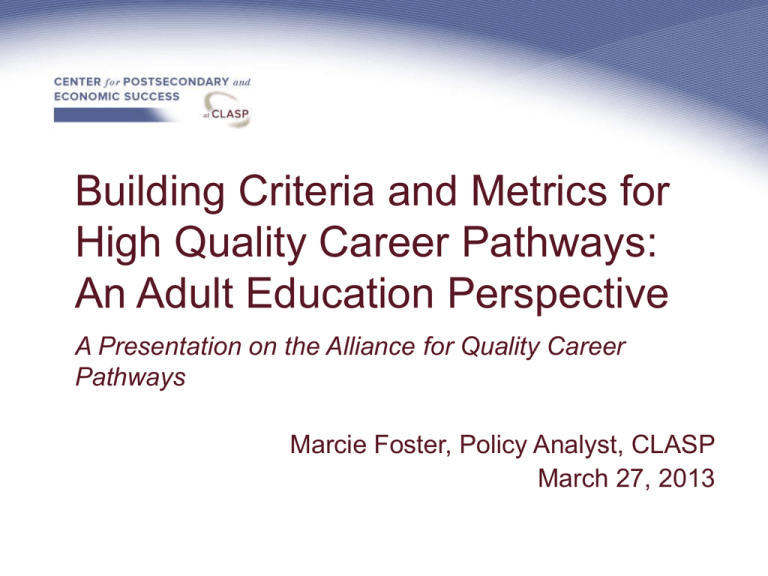
Building Criteria and Metrics for High Quality Career Pathways: An Adult Education Perspective A Presentation on the Alliance for Quality Career Pathways Marcie Foster, Policy Analyst, CLASP March 27, 2013 CLASP: Policy Solutions that Work for Low-Income People • CLASP develops and advocates for policies that improve the lives of low-income people. • Our Center for Postsecondary and Economic Success, launched in 2010, advocates for policies, investments, and political will that help increase the number of income adults and out-of-school youth who earn postsecondary credentials. • CLASP managed the Shifting Gears initiative and provided technical assistance to the six partner states. Shifting Gears supported state-level inter-agency teams to build pathways to postsecondary credentials for low-skilled adults in the Midwest. Career Pathway—The Basic Idea (borrowed from the Wisconsin Technical College System and Dept. of Workforce Development) Education Industry With Jobs Topdarkgreen Degree or Diploma Credential Credential Credential Skilled ? Bridge High School or Less For workers: • Predictable path to job advancement and higher wages • More employer support; easier access to education • More security Low Skill For employers: • Larger pool of qualified workers • Better pipeline to fill skilled jobs from within • Higher retention, employee loyalty 3 Alliance Career Pathways Model Multiple entry points (Customizable based on labor market needs and target population) Employability Skills and Work Experience (Customizable based on labor market needs and target population) Basic Skills Instruction: Adult Basic Education, English as a Second Language Short-term certificates Long-term certificates Two-Year Degree Programs and Above Basic Skills Bridge Programs Basic Career Readiness Basic occupational skills Quality Work Experiences Intermediate occupational skills Quality Work Experiences High occupational skills Quality Work Experiences Family-supporting employment and further educational opportunities Academic Skills and Credentials Multiple exit points at successively higher levels of education and employment Supportive Services and Navigation Assistance Employer Engagement Appropriate Assessment of Skills and Needs 4 Career Pathway Programs and Systems – Working Definitions • CAREER PATHWAYS are comprehensive sequences of education and training - with multiple entry and exit points, and support services and navigation assistance. • CAREER PATHWAY PROGRAMS are the building blocks of career pathways - with learner centered education, participant assessment, support services, and quality work experiences. • CAREER PATHWAY SYSTEMS are the partnerships, policies, and cultural changes that support career pathways and programs - at both the local/regional level and the state level. Includes: shared vision, leadership, demand driven employer engagement, alignment of policies, use of data, etc. 5 Philanthropic Support for Career Pathways • Seeded innovations and took to scale promising practices through large-scale, multi-site initiatives supporting career pathways and related strategies: o Bridges to Opportunity (Ford Foundation) o NGA Pathways to Advancement (Lumina Foundation) o Breaking Through (Charles Stewart Mott Foundation, North Carolina GlaxoSmithKline Foundation, Ford Foundation, Bill & Melinda Gates Foundation, and Walmart Foundation) o Shifting Gears (Joyce Foundation) • New efforts to scale promising Washington State’s I-BEST career pathway bridge practices through Accelerating Opportunity (Bill & Melinda Gates Foundation, Joyce Foundation, W.K. Kellogg Foundation, Kresge Foundation, and Open Society Foundations) 6 Recent Federal Support for Career Pathways • Grants • Health Profession Opportunity Grants (HHS, 2010) • Workforce Innovation Fund and TAACCCT (round II) grants (DOL, summer/fall 2012) • Advancing Career and Technical Education in State and Local Career Pathway Systems (ED, 2013) • Guidance and TA • • • • Policy to Performance (OVAE, 2010-2012) Integrated Education and Training Program Memorandum (ED, 2010) Federal Career Pathways Institute (DOL, ED, HHS, 2010-2011) Joint letter of commitment to promote career pathways (DOL, ED, HHS, April 2012) • Evaluation • ISIS evaluation of career pathway programs (HHS, launched in late 2007; 10 year initiative) 7 Looking Forward • Spring 2013: WIF “Pay for Success” model • TAACCCT rounds III (April 2013) and IV (tent.) • President supporting a Community College to Career Fund • Pathways Back to Work Fund (tent.) All indications are that the federal government will continue to support and promote career pathways. State Support for Career Pathways • At least 11 states have significant career pathway efforts aimed at adults or out of school youth. – AR, CA, FL, KY, IL, MA, OH, OR, VA, WA, WI • At least 13 states have significant career pathway bridge initiatives. – IL, IN, KY, KS, LA, MD, MN, NC, OH, OR, VA, WA, WI • Hundreds of local, career-focused basic skills bridge programs, according to 2010 Workforce Strategy Center bridge survey. Little uniformity. 9 er 10 Summary Career Pathways: The State of the Field + Experimentation in adult education with “transition” programs and bridge programs. + Significant experimentation at the local and state level. + Early promising evidence of student success, credential attainment, and positive labor market outcomes. + Increasing interest in scaling, yet confusing array of guidance on best practices and policies. + Urgency to build new programs and systems because of labor market needs and economic imperative for workers. = A need to develop evidence-based understanding of high quality career pathway systems and programs to move the field forward and ensure quality. 11 The Alliance for Quality Career Pathways • Funded by the Joyce Foundation and the James Irvine Foundation • The goal of AQCP is to develop a framework that defines high-quality career pathway systems and programs and includes: – Quality criteria and indicators – A shared set of performance metrics for measuring and managing their success • CLASP is the lead and facilitator 12 Alliance for Quality Career Pathways (cont.) • 10 Alliance States: Arkansas, California, Illinois, Kentucky, Massachusetts, Minnesota, Oregon, Virginia, Washington, and Wisconsin. • National Advisory Group of ~15 national organizations and experts including WSC, JFF, NSC, CORD, CEWD, Working Poor Families Project, Abt Associates, ConnectEd, and CTE and adult education state directors. The Alliance for Quality Career Pathways (cont.) • The Alliance will produce a customizable framework and self-assessment tool that can be used to: – Enhance quality of existing career pathway efforts; – Fast track and improve new career pathway efforts; and – Inform evaluation(s) of career pathway efforts. 14 AQCP Timeline Release Beta Version (Spring 2013) Release Version 1.0 (Spring 2014) • Beta testing among Alliance States. • Feedback from stakeholders, practitioners, policymakers, and others. • Disseminated to stakeholders. • Feedback from stakeholders, practitioners, policymakers, and others. Guiding Principles For Career Pathways (both state and local/regional systems) PRINCIPLE 1: Adopt and articulate a shared vision. PRINCIPLE 2: Demonstrate leadership and commitment to institutionalizing career pathways. PRINCIPLE 3: Ensure that career pathways are demand-driven, focused on sectors/occupations, and deeply engage employers. PRINCIPLE 4: Align policies, measures, and funding. PRINCIPLE 5: Use and promote data and continuous improvement strategies. PRINCIPLE 6: Enhance the capacity of partners to implement the shared vision. Anticipated Uses of the Alliance Framework • State and local career pathway partners: – Use the Alliance’s shared vision and definitions of career pathways and systems to develop and improve state and local/regional career pathway efforts. – Include multiple types of career pathways in states and communities under the Alliance’s inclusive “umbrella” vision. – Use the evidence-based, expert practitioner reviewed criteria and indicators to improve career pathway efforts. – Use the Alliance’s set of shared performance metrics to measure and manage career pathway success. – May be able to use the Alliance’s shared metrics for federal performance waivers. • Foundations can use the framework to provide capacity building and TA to help grantees build quality systems and programs • Federal agency staff are interested the framework 17 Career Pathways Funding Toolkit • Newly released this week! Visit www.clasp.org. • State and program administrators can use to identify funding opportunities across 10 federal programs to support career pathways elements. Thank you! (Keep in touch.) Contact Us: Marcie Foster mwmfoster@clasp.org Visit the Alliance Website: www.clasp.org/careerpathways Sign up to receive a bi-annual newsletter regarding the progress on AQCP and other relevant career pathways news. 19

